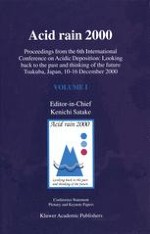The Acid Rain 2000 Conference in Tsukuba, Japan, held 10-16 December 2000, was the sixth such conference in the series, starting with Columbus, Ohio, USA, in 1975, and including Sandefjord, Norway, in 1980, Muskoka, Canada, in 1985, Glasgow, UK, in 1990, and Göteborg, Sweden, in 1995. This series of International Conferences on the acid rain problem has made a very important contribution to the process of summarising the state of current understanding and making this information available. In the 6th Conference, approximately 600 papers were presented, including talks and posters. About 300 peer-reviewed papers from the presentation appear in this volume, and will provide readers with a comprehensive review of the history and scientific aspects of the acid rain problem. The papers appear in three volumes: the first containing the plenary and keynote papers and the other two the remaining scientific papers. (Volume 1: ISBN 0-7923-7132-1; Volume 2: ISBN 0-7923-7133-X; Volume 3: ISBN 0-7923-7134-8).
The Conference was arranged under the joint auspices of The Science Council of Japan, The Japanese Society of Limnology (representative academic society), Japan Association of Aerosol Science and Technology, The Japan Society for Analytical Chemistry, Japan Society for Atmospheric Environment, Chemical Society of Japan, The Ecological Society of Japan, The Japanese Society of Environmental Education, Society of Environmental Science, Japan, The Japanese Forestry Society, Japanese Society of Snow and Ice, Japanese Society of Soil Science and Plant Nutrition, and Japan Society on Water Environment, with the cooperation of Ibaraki Prefecture and Japan Environment Agency.
